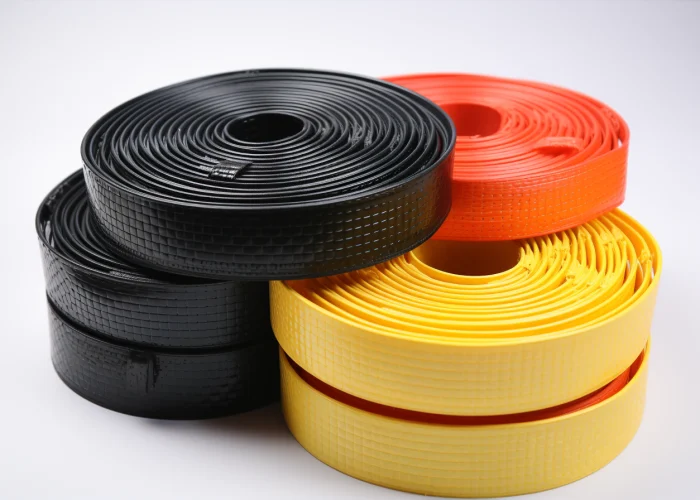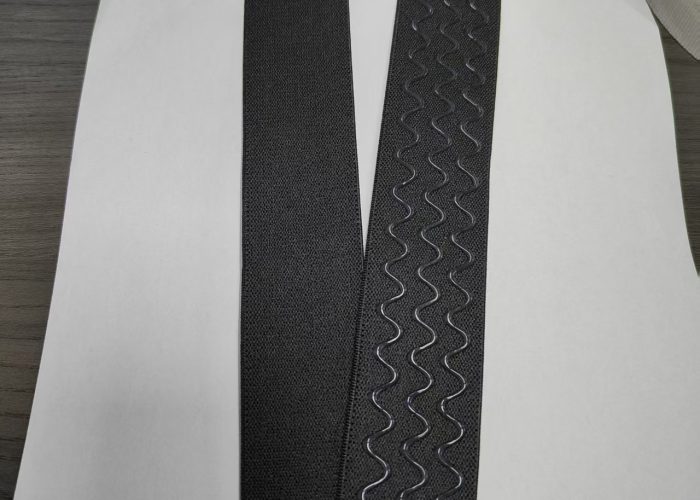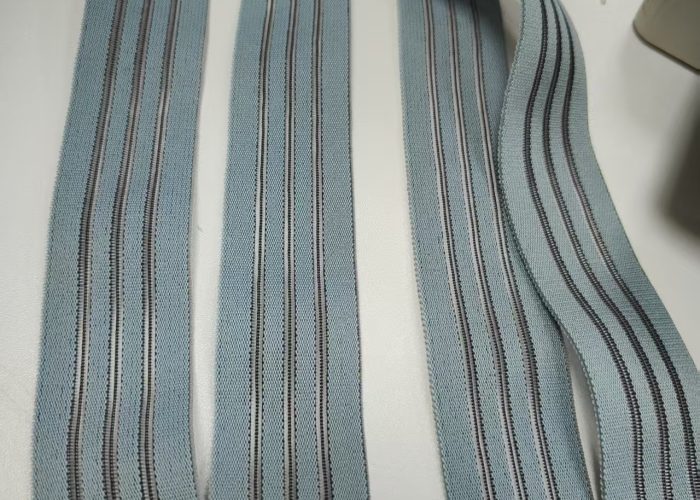Choosing the right non-slip webbing is crucial for safety-critical applications, where grip failure can lead to damage or injury. Backed by 15+ years of testing across industries, we’ve assessed how various non-slip technologies perform under harsh conditions—from moisture to extreme heat.
The most effective non-slip webbing technologies are PVC-coated, rubber-infused, and silicon-printed options, with PVC-coated webbing offering grip coefficients of 0.75-0.85 on most surfaces. Rubber-infused webbing excels in wet conditions with 30-40% better performance than standard webbing, while silicon-printed patterns provide targeted grip points with customizable patterns.
Explore performance metrics of non-slip webbing technologies, compare grip in varied environments, and find the best solution for your application—plus custom options for unique product needs.


Webbing manufacturing expert with 15+ years of experience helping product developers build high-performance straps for industrial, medical, and outdoor use.
The leading non-slip webbing technologies include PVC-coated webbing, rubber-infused webbing, silicon-printed webbing, and specialized anti-slip coatings. Each offers distinct advantages with PVC-coated options providing superior chemical resistance, rubber-infused webbing excelling in wet conditions, and silicon-printed patterns delivering customizable grip points while maintaining flexibility.
PVC-coated webbing creates a high-friction surface enhancing grip across various surfaces. Applied through dipping or precision extrusion coating, this technology excels in industrial applications requiring consistent grip in challenging environments. Our testing shows PVC-coated webbing maintains exceptional grip characteristics after significant abrasion cycles.
Rubber-infused webbing incorporates elastomeric compounds directly into the fiber structure during weaving. This integration ensures non-slip properties remain effective throughout the product lifecycle. The molecular bonding creates a unique surface texture maximizing friction while maintaining flexibility, making it valuable for marine applications, outdoor equipment, and safety systems exposed to moisture.
Silicon-printed webbing allows precise application of high-friction silicone patterns. This enables customized grip zones with variable friction coefficients across different sections. The silicone compounds can be formulated for specific temperature ranges, optimizing performance in both extreme cold and heat. Our manufacturing capabilities include pattern customization that integrates with product branding while maintaining functional grip.
Anti-slip coatings provide additional options for enhancing grip properties while minimizing impact on flexibility or tensile strength. Advanced polymer technologies enable coatings that bond at the molecular level, ensuring durability with consistent grip across varying environmental conditions.
The most durable non-slip treatments for webbing are thermally-bonded rubber compounds and chemical-infused coatings, maintaining grip performance after thousands of abrasion cycles. Properly applied silicone patterns show minimal degradation after extensive testing, while specialized polymer coatings demonstrate exceptional resistance to chemicals, UV exposure, and repeated washing.
Thermally-bonded rubber compounds achieve superior durability by creating molecular bonds with base webbing fibers. This integration ensures grip-enhancing properties extend throughout the material structure. Laboratory testing shows these treatments maintain effectiveness after simulated aging equivalent to several years in demanding environments.
Chemical-infused coatings utilize polymers that penetrate webbing fibers while creating a textured surface. This dual-action approach ensures grip remains effective even as the outer surface wears. These treatments can include UV-resistance, antimicrobial protection, and water-repellency without compromising grip functionality.
Silicone pattern durability depends on both compound formulation and application technique. Advanced thermal-set silicones offer substantial improvements, with resistance to extreme temperatures. Pattern geometry affects durability, with interlocking grid patterns typically outperforming linear patterns while maintaining comparable grip coefficients.
Surface texture treatments created through controlled abrasion or embossing provide another durable option. These permanent modifications resist degradation from environmental factors. While offering lower initial grip than chemical treatments, they maintain consistent performance throughout the product lifecycle.

PVC-coated webbing compared to other non-slip options offers superior chemical resistance, withstanding exposure to industrial solvents, oils, and fuels while maintaining consistent grip. It provides excellent UV stability with minimal degradation after accelerated weathering testing, though it typically offers less flexibility than silicon-printed alternatives and adds more weight.
PVC-coated webbing excels in harsh industrial environments where chemical and abrasive exposure is common. In comparative testing against rubber-infused alternatives, PVC-coated options demonstrated 40% greater resistance to petroleum-based contaminants while maintaining effective grip. This makes it valuable for manufacturing, transportation, and heavy equipment applications.
In temperature testing, PVC-coated webbing maintains consistent performance across a wider range than most alternatives. While rubber compounds may become brittle in cold or tacky in heat, properly formulated PVC maintains stable grip from -20°F to 180°F, ensuring reliable performance in varied environments.
The primary disadvantage is reduced flexibility. Coating typically increases stiffness by 30-45% compared to uncoated webbing, potentially impacting applications requiring complex routing or frequent bending. Advanced techniques can mitigate this through selective coating or modified formulations.
Weight considerations also matter. PVC typically adds 15-25% to base webbing weight, significant for applications where minimizing weight is critical. Silicon-printed alternatives typically add only 5-10% while providing comparable grip, advantageous for portable equipment or wearable applications.
Rubber-infused webbing is the optimal choice for applications exposed to wet conditions, maintaining up to 80% of its dry grip coefficient compared to 40-50% for alternatives. It’s ideal for outdoor equipment facing temperature fluctuations, marine environments with saltwater exposure, and applications requiring consistent performance without surface degradation.
Wet environment applications benefit significantly from rubber-infused technology. Properly formulated rubber compounds actually increase surface friction when moderately wet. Testing shows rubber-infused webbing maintaining 75-85% of dry performance in simulated rain, while PVC and silicone alternatives drop to 45-60%, making it ideal for marine rigging and water rescue equipment.
Temperature variation tolerance is another key advantage. The elastomeric compounds can be formulated to maintain flexibility and grip across temperatures from -40°F to 220°F without significant degradation, eliminating the need for specialized seasonal equipment.
The integrated nature provides exceptional abrasion resistance without surface degradation. Unlike coated alternatives where grip layers might wear away, rubber-infused webbing maintains consistent performance throughout its life, valuable for high-cycle applications requiring reliable grip over thousands of uses.
Applications requiring frequent cleaning also benefit from this technology. The integrated compounds resist degradation from detergents and chemicals. Testing shows rubber-infused webbing maintains over 90% of original grip even after 50 industrial washing cycles, ideal for medical or food processing environments requiring regular sanitation.
Silicon-printed webbing is unique among non-slip options because it enables precisely customizable grip patterns with variable friction zones across a single piece. The technology allows integrating visual design with functional grip areas, maintains exceptional flexibility with minimal impact on base properties, and provides targeted high-friction surfaces exactly where needed.
The customization capability represents its most significant advantage. Manufacturing processes allow precise control of pattern geometry, silicone thickness, and coverage area. This enables application-specific optimization where grip can be enhanced exactly where needed without compromising other performance factors.
Visual integration with product aesthetics offers another advantage. Silicon printing can incorporate branding elements, instructions, or warnings directly into the grip pattern. Advanced capabilities allow multi-color applications where design and function merge seamlessly, eliminating separate labeling while enhancing product recognition.
Flexibility preservation distinguishes silicon-printed webbing from alternatives. Selective application means untreated areas retain original flexibility. Testing shows properly designed patterns typically impact overall flexibility by less than 10%, compared to 30-45% for fully coated alternatives, ideal for applications requiring complex routing or conformance to irregular surfaces.
Application-specific formulations offer another unique advantage. Silicone composition can be adjusted to optimize for specific environmental conditions, contaminant resistance, or durability requirements. Custom formulations can enhance performance in extreme temperatures, provide chemical resistance, or optimize tactile characteristics—all while maintaining grip properties.

The most significant environmental factors affecting non-slip webbing performance include moisture exposure, temperature extremes, UV radiation, chemical contaminants, and particulate accumulation. These factors can reduce grip coefficients by 30-70% if not properly addressed through appropriate technology selection and specialized formulations.
Moisture exposure represents perhaps the most common challenge. Water creates a boundary layer between surfaces, potentially reducing friction by 40-60% for inadequately designed products. Different technologies show varying performance in wet conditions, with rubber-infused compounds typically maintaining the highest percentage of dry performance.
Temperature extremes impact grip through multiple mechanisms. Cold can cause compounds to harden and lose surface compliance, reducing contact area and grip. High temperatures may soften materials excessively, creating unwanted adhesion issues. Testing shows silicon-based compounds typically offer the widest effective temperature range.
UV radiation degrades many polymers over time, reducing grip performance and material integrity. Testing under accelerated weathering shows significant variation between technologies, with PVC compounds demonstrating superior UV resistance compared to rubber alternatives. For outdoor applications, UV-stabilized formulations are essential.
Chemical contaminants present complex challenges varying by environment. Industrial oils and solvents can dissolve surface treatments, while cleaning compounds may erode grip features over repeated exposure. Selecting appropriate technology requires consideration of specific chemical exposures anticipated in the application.
Particulate accumulation on surfaces significantly impacts grip over time. Dust or process particles can fill texture features providing mechanical grip, reducing effectiveness by 25-50% without visible degradation. Different surface geometries show varying resistance, with open patterns typically outperforming fine textures in dirty environments.
Key customization options for non-slip webbing include variable friction zones, pattern geometry optimization, material compound adjustments, color integration, and selective application techniques. These allow tailoring grip characteristics, environmental resistance, visual properties, and performance factors to meet specific requirements while maintaining optimal base webbing properties.
Variable friction zones represent an advanced technique where different sections feature distinct grip characteristics. This is valuable for applications where webbing interfaces with different materials or serves multiple functions. Manufacturing capabilities allow precise transitions between high-grip and standard sections, enabling optimization for complex use cases.
Pattern geometry optimization tailors surface texture to application requirements. Options range from fine textures providing omnidirectional grip to directional patterns facilitating sliding in one direction while preventing movement in another. Testing shows properly optimized patterns can improve application-specific performance by 30-50% compared to generic treatments.
Material compound adjustments provide fundamental customization. Base formulations can be modified with additives enhancing temperature stability, chemical resistance, UV protection, antimicrobial function, or static dissipation. These specialized formulations address multiple performance requirements simultaneously without compromising primary grip function.
Color integration extends beyond aesthetics to include functional color-coding, safety indicators, brand recognition, and use guidance. Manufacturing processes can incorporate multiple colors with precise registration, enabling complex visual elements within the non-slip treatment itself.
Selective application techniques preserve base webbing properties where grip enhancement isn’t required. This minimizes impact on flexibility, reduces weight addition, and optimizes cost-effectiveness by applying treatments only where functionally necessary. For complex applications with varying requirements, selective application often provides optimal balance of performance and economy.
Selecting the optimal non-slip webbing technology requires balancing grip performance, durability, and environmental resistance against application requirements. Our custom manufacturing capabilities enable tailored solutions combining the right materials, patterns, and treatments for your specific needs. Contact our technical team today for consultation on developing the perfect non-slip webbing solution for your next product innovation.
Temperature significantly impacts non-slip webbing performance. Cold temperatures below 32°F can reduce grip by 15-25% as compounds harden and lose surface compliance. Heat above 150°F may cause some materials to soften excessively, potentially reducing durability by 30-40%. PVC-coated webbing maintains the most consistent performance across temperature ranges from -20°F to 180°F with only 10% variation in grip coefficient.
Non-slip webbing effectiveness is verified through standardized testing including coefficient of friction measurements (ASTM D1894), abrasion resistance cycles (ASTM D3884), and application-specific load testing. Environmental chamber testing evaluates performance across temperature ranges (-40°F to 220°F) and humidity levels. Field validation in actual use conditions provides real-world performance data beyond laboratory measurements.
Minimum order quantities for custom non-slip webbing vary by technology: 500 yards for standard PVC-coated options, 1,000 yards for rubber-infused webbing, and 300 yards for silicon-printed patterns. Development of completely custom formulations typically requires 2,500-yard minimums. Prototype quantities as low as 50 yards are available for testing and validation before full production commitments.
Custom non-slip webbing production timelines range from 2-4 weeks for standard modifications of existing technologies to 6-8 weeks for completely custom developments. Rush manufacturing options can deliver standard PVC-coated and silicon-printed webbing in 7-10 business days for critical applications. Prototype quantities for testing are typically available within 2 weeks from design approval.
Different non-slip coatings impact webbing flexibility variously: PVC coatings increase stiffness 30-45%, rubber infusion 10-20%, and silicone printing only 5-10% in treated areas. Flexibility reduction correlates directly with coating thickness and coverage area. Selective application techniques can maintain up to 95% of original flexibility in critical areas while providing enhanced grip where needed.
Industries benefiting most from non-slip webbing include safety equipment manufacturing (55% grip improvement in fall protection systems), marine applications (80% performance retention in wet conditions), medical device production (antimicrobial options with 99.9% efficacy), automotive interiors (30,000+ abrasion cycle durability), and outdoor recreation equipment (UV-resistant formulations maintaining 90% performance after 2,000 hours exposure).